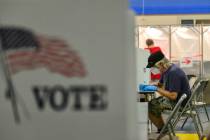BLOG: There’s at least a dollar’s worth of difference between Democratic, Republican plans
Author’s note: This blog has been altered from its original version to correct an error.
Who says there’s not a dime’s worth of difference between the Democratic and Republican parties?
OK, it was former Alabama Gov. George Wallace. And on many occasions, his point remains valid.
But when it comes to the competing legislative agendas of Nevada’s Democratic and Republican caucuses, not only is there a difference, there’s few things in common. Reading through the Nevada Blueprint (Democratic Senate and Assembly plan) and A Pathway Forward for All Nevadans (Republican state Senate caucus plan), you can see plenty of differences.
Democrats want “school choice” — provided it’s within the confines of a public school district. Republicans want Education Savings Accounts, which allow parents to use a portion of the state’s per-pupil school funding for things including tuition at private schools, explicitly outside the tax-supported schools.
Democrats want to “keep public lands in public hands,” whereas Republicans want to transfer federal public lands to the state “responsibly.” (A wholesale transfer of all or even most federal public lands to state control would likely overwhelm Nevada’s meager land-management resources.)
Democrats want to keep voting “free, fair and accessible to everyone.” Republicans want to implement a photo ID requirement for people to vote.
Democrats want equal pay for women, earned sick leave, and a requirement for health insurance companies to cover basic care. Republicans want to reduce regulations and red tape on business.
Democrats want to make Nevada a leader in the clean energy economy. Republicans want “common sense” green energy reforms.
There are ironies in both documents. For example, the Democratic plan calls for honoring Nevada’s culture of freedom and personal liberty … by enacting laws to outlaw discrimination regardless of race, ethnicity, gender, sexual orientation, religion or immigration status. The Republican plan pledges GOP senators will “fight against increases to or expansions of business taxes” — just one session after now-Minority Leader Michael Roberson and several signatories to the Pathway helped enact the largest business tax increase in Nevada history.
And there are areas where both parties should be able to agree in both documents. For example, everybody should be able to get behind the idea of providing funds for training workers for high-tech jobs in the state, as called for in the Blueprint. And nobody could be against increasing penalties for people convicted of abusing the elderly, or working on building the Interstate 11, as the Framework demands. The plans explicitly agree on funding the UNLV medical school.
And there are some surprises in both plans, too. Republicans in the Framework call for policies to provide for more transparency in political contributions. Democrats want to spur small business with loans, reduced red-tape, and small-business incubators.
And both plans include elements that mirror the agenda that Gov. Brian Sandoval outlined in his State of the State address back in January.
Senate Majority Leader Aaron Ford, D-Las Vegas, said in his opening-day speech that the Blueprint will govern how Democrats in both houses view all legislation that comes before them in the current session. The Framework appears to be an answer to the Democratic document, with a few hot-button issues tossed in to generate Democratic ire.
But if no order of battle survives first contact with the enemy, no legislative agenda lives through an entire session intact, especially when it comes to the endgame. There, platform planks and principle lists give way to the pragmatism of compromise, and meeting that unforgiving 120th-day deadline.






















